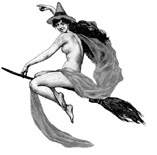
Medium Unwell
A NEW AGE OF NEW AGE
A few years ago, an old family friend called with some rather unusual news. Her daughter, who is about my age, had taken up a new career. She had been a small-business owner, running a perfectly respectable catering service and, apparently, doing rather well for herself. But a divorce had caused her to think more deeply about the fleeting nature of things. She began to consult mediums, people who claim to be able to communicate with the dead. Before long, she, too, was talking to dead people. And they were talking back to her. My childhood friend had found a second calling. The little girl who used to play in our group of toddlers some 45 years ago is now a medium herself. She provides, according to her business website, energy coaching, spirit readings, and messaging with loved ones “on the other side.”
We all grew up Catholic in southern Louisiana. Our parents and grandparents would have dragged us by the ear to talk to a priest if we ever spouted off about séancing with spirits or giving “psychic readings.” If I had ever mentioned in passing that I’d been having conversations with dead people, I would have found myself, courtesy of someone in my immediate family, in a confessional sweating bullets in no time flat. Our old family friend, alas, had moved off to California years ago, and over time she — and her kids, my childhood friends — gradually slid from Catholic to Catholic-inflected New Age. She has had a lifelong devotion to St. Anthony, but in phone calls from out West she took to calling him “Tony,” explaining how he had helped her find misplaced keys or a parking spot at the mall. One of her other children — not the part-time channeler of spirits from the great beyond — began wearing his Rosary instead of praying it. This led, our friend explained, to his seeing “visions of Jesus” during a bout with a serious illness. Right. I bet.
It was easy to dismiss all this as West Coast weirdness, to laugh it off as something that happens when totally uncosmopolitan and guileless swamp-dwellers like us set off into the big shining frontier on the other side of the Sierra Nevada. If you’ve ever seen The Beverly Hillbillies, you get the idea. Yokels showing up in California are bound to run into trouble. In my friends’ case, the trouble came in the form of “manifesting” and other such nonsense. But it had been years since I had spoken to any of them, so I just shrugged and thought, well, that’s what you get when Cajuns start mixing it up with Valley Girls. It gave me the creeps to know that someone I used to ride tricycles with had hung out her shingle as a medium, but our past was long ago and far away, and the trade she plies now has nothing to do with me.
Or so I thought. The more I turned the matter over in my mind, the less sure I became that what my former childhood playmate was up to was that much different than how we had been raised.
You May Also Enjoy
Catholics need not look to revamped pagan religions for spiritual enrichment, especially since these religions contain grave error.
The Joplin tornado of May 2011 showed the populace had come to rely on media in place of their own eyeballs for weather reports.
Peace has been a consistent message of Leo’s early in his tenure, and in this he is in continuity with his 20th- and 21st-century predecessors.

